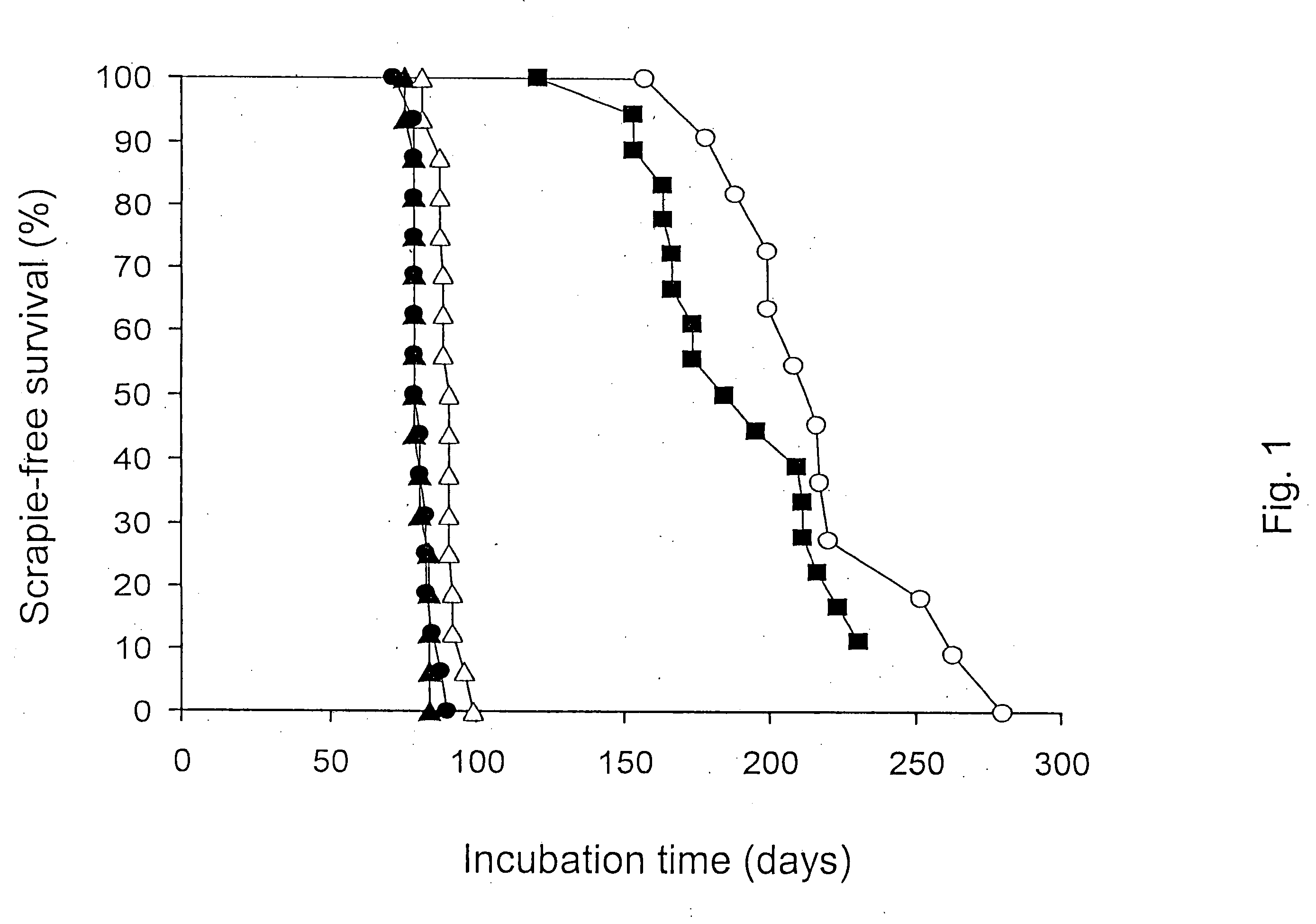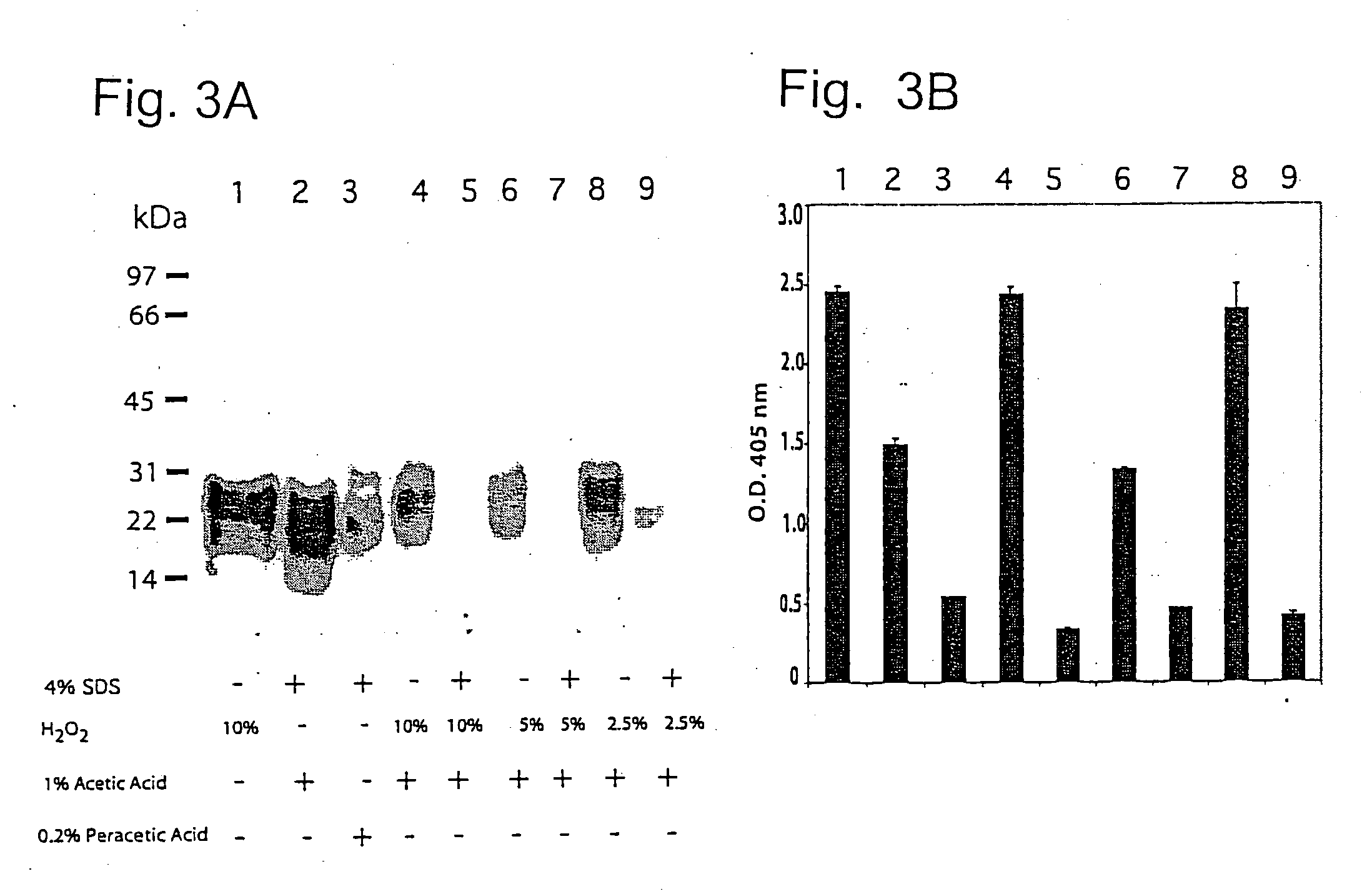Complete inactivation of infectious proteins
a technology of infectious proteins and inactivation, applied in the field of disinfectants, can solve the problems that sds solutions at neutral ph, even at high temperatures, cannot be reliably used for prion decontamination, and the previous attempts to disinfect prions with neutral solutions of sds yielded mixed results, etc., and achieves the effect of short period of tim
- Summary
- Abstract
- Description
- Claims
- Application Information
AI Technical Summary
Benefits of technology
Problems solved by technology
Method used
Image
Examples
example 1
Effect of SDS, Acidic pH, and Temperature on Prion Infectivity
[0078] Samples of 1% Sc237-infected SHa brain homogenate containing 107 ID50 units prion infectivity / ml were incubated with continuous shaking for 2 h in the specified buffer at the indicated temperature. Following incubation, samples were diluted 1:10 into PBS without calcium or magnesium plus 5 mg / ml BSA, and 50 μl aliquots were inoculated into 8 separate Syrian hamsters. The results are plotted in FIG. 1 where the filled triangles are data for 1% NP40; 50 mM Tris Acetate, pH 7.0 at 37° C.; the filled circles are data for 1% NP40; 0.5% acetic acid, pH 3.6 at 37° C.; the open triangles are data for 1% SDS; 50 mM Tris Acetate, pH 7.0 at 37° C.; the closed squares are data for 1% SDS; 0.5% acetic acid, pH 3.6 at 20° C.; and the open circles are data for 1% SDS; 0.5% acetic acid, pH 3.6 at 37° C.; (open squares) 1% SDS; 0.5% acetic acid, pH 3.6 at 65° C.
example 2
Effect of Detergent and pH on Protease-Resistant PrPSC
[0079] Samples of 1% Sc237-infected SHa brain homogenate were incubated for 15 min at 37° C. with detergent at the range of pH values indicated. Fifty mM sodium acetate buffers were used to maintain pH values 3 to 6, and 50 mM Tris acetate buffers were used to maintain pH values 7 to 10. The final pH value of each sample denoted above each corresponding lane was measured directly with a calibrated pH electrode (Radiometer Copenhagen). Following incubation, all samples were neutralized by the addition of an equal volume of 4% Sarkosyl; 100 mM HEPES, pH 7.5; 200 mM NaCl and subjected to limited proteolysis with 20 μg / ml proteinase K for 1 h at 37° C. These results are shown in FIG. 2A.
[0080] Samples of 1% Sc237-infected SHa brain homogenate were incubated for 15 min at 37° C. in 1% SDS plus (1) 50 mM Tris acetate, pH 7.0; (2) 0.5% acetic acid, pH 3.6; (3) 50 mM glycine, pH 3.7; or (4) 0.2% peracetic acid (Sigma-Aldrich), pH 3.4. ...
example 3
[0082] Samples of 20% Sc237-infected brain homogenate (10 μl / 200 μg) were incubated with (+) or without (−) the following reagents; 1) 4% SDS, 2) different concentrations of H2O2, 3) 1% acetic acid, and 4) 0.2% peracetic acid at room temperature for 30 min to a final volume of 40 μl. Samples (lanes 1-9 of FIG. 3A) were diluted with 280 μl of neutralization buffer to final concentration of 100 mM NaCl, 2% Sarkosyl and 200 mM HEPES pH 7.5 and were subjected to limited proteolysis with 4 μg proteinase K for 1 h at 37° C. Western blots were loaded with 24 μl / lane and the results are shown in FIG. 3A.
[0083] 280 μl were treated with 1.120 ml of methanol / chloroform and PrPSc was analyzed with ELISA as described previously [Peretz, D., R. A. Williamson, et al. (2002). “A change in the conformation of prions accompanies the emergence of a new prion strain.”Neuron 34: 921-932 and Peretz, D., R. A. Williamson, et al. (2002). Antibodies inhibit prion formation and abolish prion infectivity. Tr...
PUM
 Login to View More
Login to View More Abstract
Description
Claims
Application Information
 Login to View More
Login to View More - R&D
- Intellectual Property
- Life Sciences
- Materials
- Tech Scout
- Unparalleled Data Quality
- Higher Quality Content
- 60% Fewer Hallucinations
Browse by: Latest US Patents, China's latest patents, Technical Efficacy Thesaurus, Application Domain, Technology Topic, Popular Technical Reports.
© 2025 PatSnap. All rights reserved.Legal|Privacy policy|Modern Slavery Act Transparency Statement|Sitemap|About US| Contact US: help@patsnap.com



